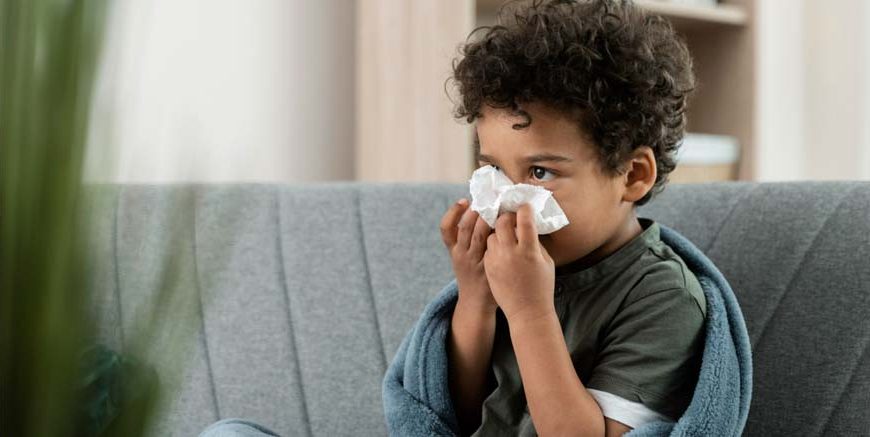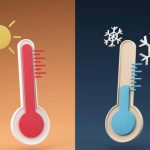Allergic rhinitis is a non-communicable disease that has rapidly increased in incidence in the country over the past few decades. It is an inflammation of the mucosa of the nose causing physical symptoms such as a “runny nose”, and bouts of sneezing, usually associated with watering of the eyes. An Indian study reported that the prevalence of allergic rhinitis was 11.3% in children aged 6–7 years and 24.4% in children aged 13–14 years.
Table of Contents
- What is allergic rhinitis?
- What are the symptoms of allergic rhinitis?
- What causes allergic rhinitis?
- Why are children more likely than adults to get allergic rhinitis?
- How does a doctor diagnose allergic rhinitis?
- What happens if my child keeps getting allergic rhinitis?
- Can atopic rhinitis be prevented?
- What research is being done on allergic rhinitis?
- Where can I find additional information about allergic rhinitis?
- Conclusion
What is allergic rhinitis?
A child who suffers from recurrent bouts of sneezing, watering of the nose and eyes, and itching in the nose is said to be suffering from “allergic rhinitis”. Allergic diseases occur due to an interplay between genetic and environmental factors. The concept of “united airway disease” states that upper airway (nose and throat) and lower airway (lungs) diseases often co-exist, indicating that there is a common underlying immunological factor. Therefore, 80% of asthma patients suffer from rhinitis, and 30% of rhinitis patients may have asthma. The risk of asthma in allergic rhinitis is more evident in children, compared to adults. This leads us to the conclusion that it is important to investigate and manage allergies in children, to prevent the development of asthma in adolescence.
What are the symptoms of allergic rhinitis?
- Nasal discharge dripping from the nose constantly, or a feeling of mucus dripping down the back of the nose and throat
- Blocked nose
- Sneezing – multiple sneezing attacks continuously in a short period of time – usually more in the morning
- Itchy nose, throat, eyes
- Nosebleeds – because children tend to cause injuries by scratching the inside of the nose
- Dark circles and creases under the eyes – Dennie Morgan lines
- Dark crease over the bridge of the nose due to frequent scratching or wiping of the nose – allergic salute
- Snoring during sleep due to mouth breathing
- Dry cough
- Loss of smell and taste due to a blocked nose, and a habit of mouth breathing
How can I tell if my child has allergic rhinitis?
The above-mentioned symptoms are usually a tell-tale sign of children with allergic rhinitis. Some children may develop these symptoms coinciding with a change of season or environment, whereas some may exhibit the same all through the year. A blocked nose will cause children to breathe through their mouth – causing a chronic dry cough due to dryness and these children snore and cough during sleep. Fragmented sleep, in turn, causes them to be less active in school and during play, and affects their daily life.
What causes allergic rhinitis?
India is infamous for being one of the countries with the highest concentrations of air pollution – caused by biomass, fossil fuels, and vehicle exhausts. The prevalent use of mosquito coils, incense sticks, and dhoop/agarbatti inside Indian homes also contributes to this. Children living with smokers tend to develop allergies early in life and the morbidity is higher.
Our country also has vast variations in weather throughout the year, and the meddlesome pests that come with it – such as cockroaches, fungal spores, and pollen contribute to allergic rhinitis. Food allergies are common but not easy to diagnose. Many children may also develop an allergy to animal dander from pets in the house, though it is worth mentioning that children who are exposed to pets at an age younger than 3 years are less likely to develop allergies to them later in life.
However, everyone has a different immunological profile. In simpler terms, patients are often allergic to certain substances that cause no harm to others in the same environment. The variation in symptoms is also personal to each patient. Some children may not be affected the same as others. Additionally, allergies often run in families.
Why are children more likely than adults to get allergic rhinitis?
Childhood allergic rhinitis is often overlooked and under-treated, because younger patients may not recognize or report their symptoms. Adolescents often report a poorer quality of life due to physical symptoms, whereas younger patients may not be bothered by them so often. Nevertheless, it is important to identify and manage allergies in childhood, to prevent flare-ups in adolescence and adulthood, as well as to prevent “atopic march”. This is a term used to define the natural progression of allergies in infants with eczema, to children with rhinitis, and finally, asthma at a later age.
How does a doctor diagnose allergic rhinitis?
A preliminary history of the above-mentioned complaints often gives a hint to the diagnosis. On physical examination, your doctor will examine the nose and throat of the child. The soft tissues inside the nose are swollen up and look pale bluish in these patients. Allergic shiners and allergic salute over the nose add to the diagnosis.
Raised eosinophils and serum immunoglobulin E show up in blood tests which signify the response of the patient’s system to an allergen. To identify these allergens, your doctor may recommend a skin prick test. You can also aid your doctor in this process by noticing the presence of a new substance in the child’s environment following which the symptoms worsen.
How long will it take my child to get better?
Allergy management is a complex process and is personalized depending on the child’s symptoms, age, and general health. Milder symptoms can be curtailed by reducing the exposure to known or suspected allergens. Frequent changing of bed linen, and protection from pollen, dust, cockroach waste, mites, and mold is recommended. Avoiding exposure to cigarette smoke, dhoop/agarbatti might be required, depending on the patient’s sensitivity.
Oral antihistamines and nasal steroid sprays are the mainstay of treatment. Antihistamines work by blocking the effects of histamine – the molecule released in response to allergen exposure which is responsible for physical symptoms. These help in the acute exacerbation of allergies.
Nasal steroid sprays work by reducing the inflammation and swelling inside the nose – thereby opening up the nasal airway and reducing the incidence of mouth breathing. These sprays are usually prescribed for seasonal symptoms, to be started preemptively and continued for up to 3 months at a time.
Allergen immunotherapy is the sole treatment that is effective at disease modification. It is a long form of treatment that reduces the use of other medicines and is known to provide a symptom-free period after discontinuation. Immunotherapy has the advantage of arresting the progression of rhinitis to asthma.
What happens if my child keeps getting allergic rhinitis?
Allergies can severely compromise the quality of life of the patient in any age group. Long-standing allergies also predispose to the development of bronchitis or asthma, as stated above under atopic march.
Can atopic rhinitis be prevented?
Genetic factors determining allergies cannot be predicted or controlled, but environmental exposure to allergens can be identified and reduced. Physical symptoms can be managed with antihistamines and topical steroids.
What research is being done on allergic rhinitis?
The field of allergy and immunology is usually interspersed with ENT and pulmonology in India, therefore training is sparse and mandates a multidisciplinary approach. There is scope to identify biomarkers and provide a targeted approach to allergy, rather than a blanket treatment regime.
Where can I find additional information about allergic rhinitis?
- https://www.hopkinsmedicine.org/health/conditions-and-diseases/allergic-rhinitis-in-children
- https://www.thelancet.com/journals/langlo/article/PIIS2214-109X(20)30061-9/fulltext
Conclusion
Early identification and treatment of allergic rhinitis can significantly improve your child’s quality of life. It is also crucial to devise a plan of management to avoid the development of respiratory allergies in these children later in life. If you notice any of the above-mentioned symptoms in your child or have a history of allergy in the family – do consult your pediatrician.
















